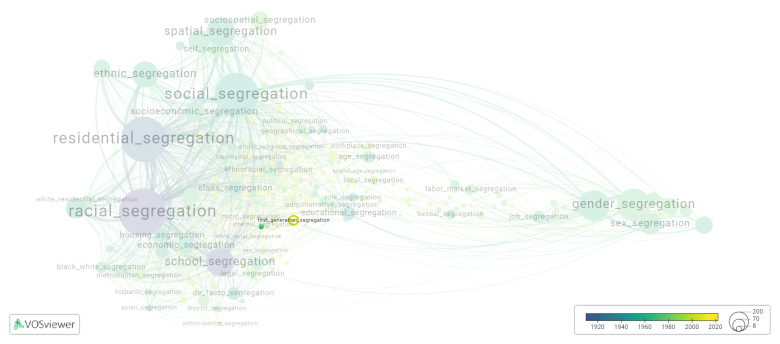First generation segregation: Difference between revisions
(Creating page) |
(Creating page) |
||
| (7 intermediate revisions by the same user not shown) | |||
| Line 5: | Line 5: | ||
First generation segregation refers to the period in the United States following the Civil War and Reconstruction when laws and policies were enacted to enforce the separation of African Americans from white Americans in public spaces, schools, housing, and other areas of society. Examples of first generation segregation include the establishment of Jim Crow laws, the Supreme Court ruling in Plessy v. Ferguson that upheld segregation as constitutional, and the formation of separate facilities and institutions for black Americans. This era of segregation lasted from the late 19th century until the mid-20th century when the Civil Rights Movement successfully challenged these discriminatory practices. | First generation segregation refers to the period in the United States following the Civil War and Reconstruction when laws and policies were enacted to enforce the separation of African Americans from white Americans in public spaces, schools, housing, and other areas of society. Examples of first generation segregation include the establishment of Jim Crow laws, the Supreme Court ruling in Plessy v. Ferguson that upheld segregation as constitutional, and the formation of separate facilities and institutions for black Americans. This era of segregation lasted from the late 19th century until the mid-20th century when the Civil Rights Movement successfully challenged these discriminatory practices. | ||
==== | ==See also== | ||
==Related segregation forms== | |||
First generation segregation is frequently discussed in the literature with the following segregation forms: | |||
[[racial segregation]], [[second generation segregation]] | |||
[[File:first_generation_segregation.png|780x780px]] | |||
This visualization is based on the study [[Segregation_Wiki:About| The Multidisciplinary Landscape of Segregation Research]]. | |||
For the complete network of interrelated segregation forms, please refer to: | |||
* [https://tinyurl.com/2235lkhw First year of publication] | |||
* [https://tinyurl.com/2d8wg5n3 Louvain clusters] | |||
* [https://tinyurl.com/223udk5r Betweenness centrality] | |||
* [https://tinyurl.com/244d8unz Disciplines in which segregation forms first emerged (Scopus database).] | |||
==References== | ==References== | ||
==Notes== | ==Notes== | ||
<references /> | <references /> | ||
{{NoteAI}} | {{NoteAI}} | ||
==First | ==First generation segregation appears in the following literature== | ||
Mickelson R.A. (2015 | Mickelson R.A. (2015). The Cumulative Disadvantages of First and Second Generation Segregation for Middle School Achievement. ''American Educational Research Journal'', ''52''(4), 657-692. SAGE Publications Inc..https://doi.org/10.3102/0002831215587933 | ||
Latest revision as of 07:17, 16 October 2024
Date and country of first publication[1][edit | edit source]
2015
United States
Definition[edit | edit source]
First generation segregation refers to the period in the United States following the Civil War and Reconstruction when laws and policies were enacted to enforce the separation of African Americans from white Americans in public spaces, schools, housing, and other areas of society. Examples of first generation segregation include the establishment of Jim Crow laws, the Supreme Court ruling in Plessy v. Ferguson that upheld segregation as constitutional, and the formation of separate facilities and institutions for black Americans. This era of segregation lasted from the late 19th century until the mid-20th century when the Civil Rights Movement successfully challenged these discriminatory practices.
See also[edit | edit source]
Related segregation forms[edit | edit source]
First generation segregation is frequently discussed in the literature with the following segregation forms:
racial segregation, second generation segregation

This visualization is based on the study The Multidisciplinary Landscape of Segregation Research.
For the complete network of interrelated segregation forms, please refer to:
References[edit | edit source]
Notes[edit | edit source]
- ↑ Date and country of first publication as informed by the Scopus database (December 2023).
At its current state, this definition has been generated by a Large Language Model (LLM) so far without review by an independent researcher or a member of the curating team of segregation experts that keep the Segregation Wiki online. While we strive for accuracy, we cannot guarantee its reliability, completeness and timeliness. Please use this content with caution and verify information as needed. Also, feel free to improve on the definition as you see fit, including the use of references and other informational resources. We value your input in enhancing the quality and accuracy of the definitions of segregation forms collectively offered in the Segregation Wiki ©.
First generation segregation appears in the following literature[edit | edit source]
Mickelson R.A. (2015). The Cumulative Disadvantages of First and Second Generation Segregation for Middle School Achievement. American Educational Research Journal, 52(4), 657-692. SAGE Publications Inc..https://doi.org/10.3102/0002831215587933
